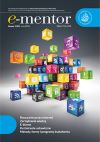Using the Seven Futures Framework for Improving Educational Quality
Using the Seven Futures Framework for Improving Educational Quality
Author(s): John SenerSubject(s): Essay|Book Review |Scientific Life
Published by: Szkoła Główna Handlowa w Warszawie, Fundacja Promocji i Akredytacji Kierunków Ekonomicznych
Keywords: Seven Futures Framework; educational quality; higher educational institutions
Summary/Abstract: One of education's defining features is that it exists to a large extent in a constant state of tension between stasis and change. Education is an inherently conservative institution in many ways, for instance regarding its function of transmitting preserved societal knowledge and its legendary ability to resist rapid change. At the same time, educational institutions are one of society's main ways of creating change through a variety of means such as groundbreaking research, discoveries, and ideas. Higher educational institutions are highly complex institutions which fulfill a multitude of purposes: employment preparation, social 'rite of passage,' knowledge generation, entertainment, economic mainstay, business partner, global outreach agent, and social change agent to name a few. Higher education has become the main vehicle for individual economic change, particularly in the U.S. where a college degree has become practically the sole remaining path to a middle-class lifestyle, although many observers argue that this reality is fading due to the shrinking of the middle class and the sharp rise in student debt in the U.S. As the Education for All movement illustrates, the ideal of education as a universal right which is essential to participating in the world's new knowledge economy and having the „individual power to reflect, make choices, and steer for a better life” is a global phenomenon, even though it is not an evenly distributed one. Despite education's legendary reputation for standing still, or at least changing so slowly that most observers don't even notice, change has long been an integral part of education. Not all opportunities for change are created equal, however. The present moment offers us a spectacular opportunity for change thanks to the confluence of two key factors: education power - education's newfound cultural importance as essential to the well-being of individuals and society - and cybersymbiosis - education's and society's irretrievable dependence on online and digital technologies. This cyberization of education is happening on a variety of levels and for a variety of reasons. The Internet has become a pervasive learning resource and an indispensable resource for formal education activities, changing expectations about how we learn and how we educate. As we become ever more proficient at using Internet and other digital technologies for teaching and learning, we can also learn how to use these technologies to improve education by cyberizing it - taking a proactive role in shaping our use of digital technologies. If the first era of online education was defined by providing access, the emerging era can be defined in terms of improving quality - not just for online education but for all education. If we do this, we can take advantage of this spectacular opportunity to improve education in deep and lasting ways.
Journal: e-mentor
- Issue Year: 53/2014
- Issue No: 1
- Page Range: 92-97
- Page Count: 6
- Language: English

